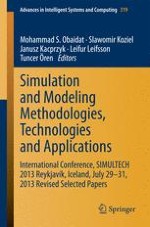This book includes extended and revised versions of a set of selected papers from the 3rd International Conference on Simulation and Modeling Methodologies, Technologies and Applications (SIMULTECH 2013) which was co-organized by the Reykjavik University (RU) and sponsored by the Institute for Systems and Technologies of Information, Control and Communication (INSTICC). SIMULTECH 2013 was held in cooperation with the ACM SIGSIM - Special Interest Group (SIG) on SImulation and Modeling (SIM), Movimento Italiano Modellazione e Simulazione (MIMOS) and AIS Special Interest Group on Modeling and Simulation (AIS SIGMAS) and technically co-sponsored by the Society for Modeling & Simulation International (SCS), Liophant Simulation, Simulation Team and International Federation for Information Processing (IFIP).
This proceedings brings together researchers, engineers, applied mathematicians and practitioners working in the advances and applications in the field of system simulation.
